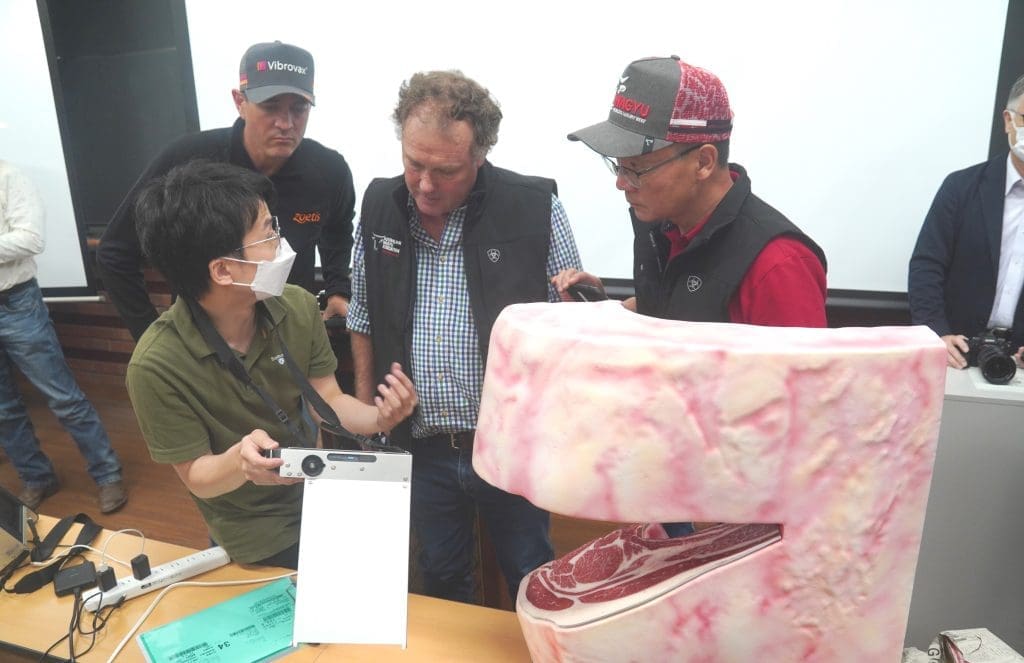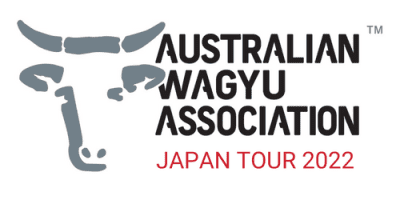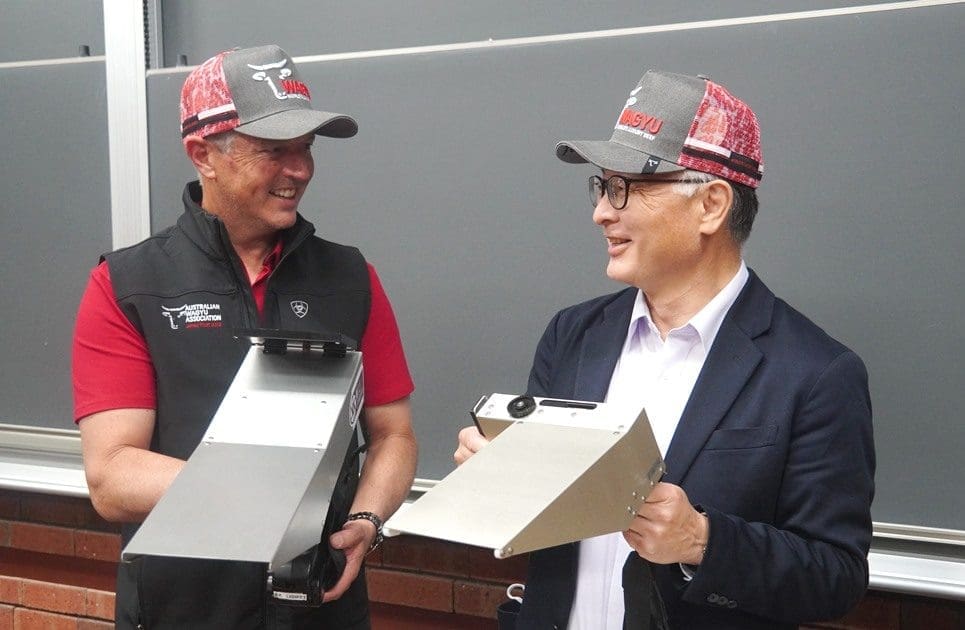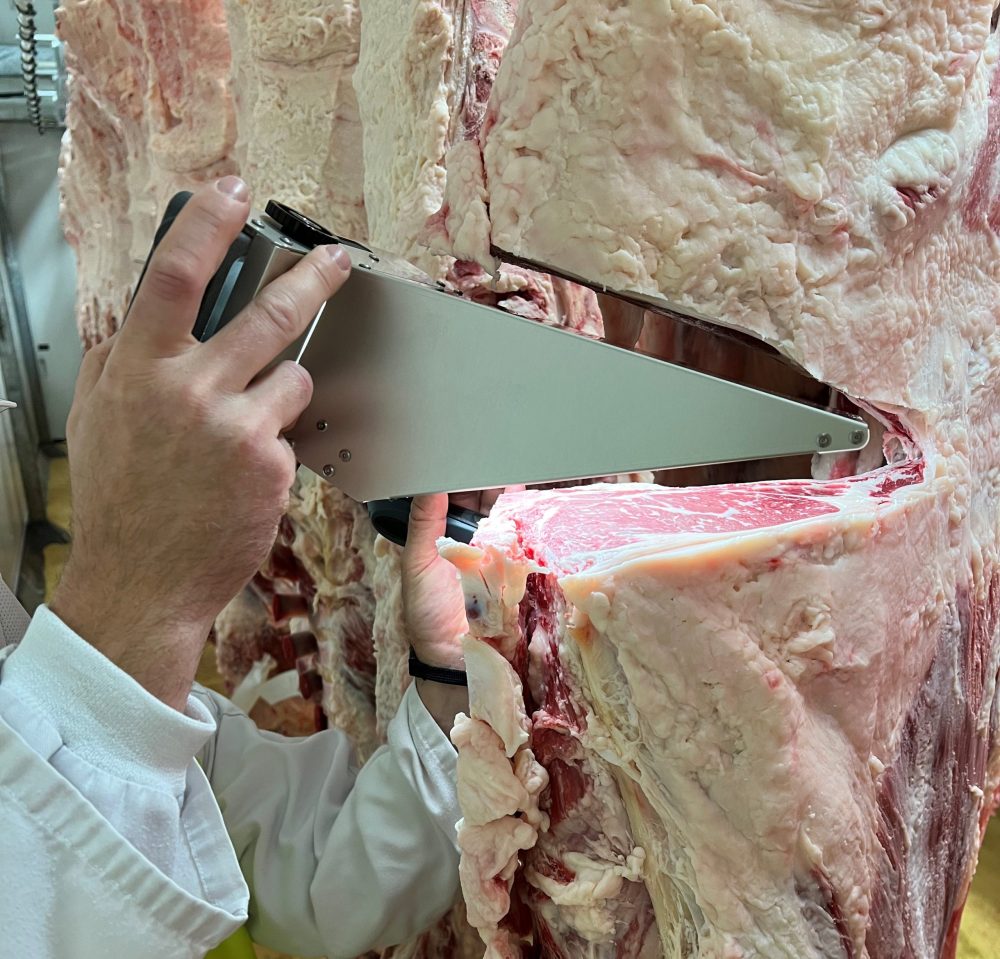
WIDESPREAD adoption of the Meat Image Japan objective carcase grading camera is helping underpin rapid genetic progress in Wagyu cattle in Australia.
While there are a number of vision-based grading camera systems now in use in the Australian beef industry, the Japanese-developed MIJ technology excels in its ability to accurately measure high-marbling Wagyu carcases for both abundance and marbling fineness. As a separate article today reports, marbling fineness is taking on increasing significance in the Wagyu industry.
 A contingent of 40 Wagyu industry stakeholders from Australia, the US and Brazil taking part in the 2022 AWA Wagyu tour of Japan this week were given a comprehensive update on the MIJ camera and new developments in the field.
A contingent of 40 Wagyu industry stakeholders from Australia, the US and Brazil taking part in the 2022 AWA Wagyu tour of Japan this week were given a comprehensive update on the MIJ camera and new developments in the field.
Twenty four of the MIJ cameras are now in use by Wagyu supply chains in various beef processing plants across Australia. Most are the latest version of the technology, called MIJ Mobile, launched at the Australian Wagyu conference in April.
The latest MIJ camera is more portable and more powerful, being only around 1kg in weight compared with the original model’s 10kg. Higher resolution cameras are used, and the technology has shown the ability to make up to 500 carcase assessments in a little over two hours under Australian conditions.
While the original MIJ cameras cost A$60,000 to purchase in 2018, technology advances have seen a dramatic decline, with the latest version only around A$4000, putting them well within reach of smaller Wagyu supply chains.
Each owner buys a unit outright, paying a small royalty fee per carcase image captured and submitted. Across the entire Australian Wagyu industry, more than 50,000 carcase images and data have now been captured.
Much of the data is fed into the Australian Wagyu Association’s genetic analysis, while some is used for internal genetic evaluation.
Australian Wagyu beef continues to be traded globally based on AusMeat marbling scores rather than MIJ camera results, but the camera data for marbling abundance and fineness, and eye muscle area, are primarily used at present to underpin carcase progeny-driven genetic selection.
The MIJ platform also has the ability to do a full carcase yield analysis based on EMA, fat cover and carcase weight, but at this time that is only calibrated for quartering at the 6/7 rib site as applied in Japan, not the Australian quartering site between ribs 12-13.
In Japan, all Wagyu carcases are officially assessed by manual graders from the Japan Meat Grading Association, many of which take 10-15 years to reach their full certification level. But increasingly, graders are using the MIJ camera in their work, before making a call on whether a carcase is eligible for the A5 premium category, or something less.
The MIJ cameras are also used in the Zenkyo National Carcase Competition held in Japan every five years (report coming on this event next week), as well as the AWA’s annual branded beef competition staged in Brisbane.
Pivotal to genetic progress
Some higher performing Australian Wagyu carcases produce marbling performance well beyond AusMeat score 9 (the Australian language’s current limit), with a number of entries in this year’s AWA branded beef competition exhibiting marbling abundance that would equate to a score 15 or 16, based on the digital marbling score produced by the MIJ camera.
“Obviously the industry is aware that these very high marbling values exist, and grading these a MB9 might not accurately describe the marbling at those very high levels under AusMeat grading,” AWA chief executive Matt McDonagh said.
“But certainly, the brand owners get the value out of that product by using brand segmentation, pushing them into ‘ultra-premium’ categories,” he said.
“So the value capture from the carcase is already there, but the trading language’s ability to describe those carcases accurately and consistently would be beneficial,” Dr McDonagh said.
“There’s no doubt that the MIJ camera has been pivotal to the rapid genetic progress being made in Australian Wagyu. Since we started using the MIJ cameras starting 2018, we now have 26,000 Fullblood carcases within the AWA genetic evaluation system, and growing rapidly as more cameras are deployed.”
The strength of the camera-driven data shone through in the heritability of the trait involved (the amount of the measured variance that can be attributed to genetics). Since the adoption of MIJ, the heritability for marbling traits in Australian Wagyu has risen from about 0.3 (representing 30pc genetic influence) up to 0.6 (60pc of genetic influence).
“This means Australian breeders can make an enormous amount of genetic gain in marbling, very, very quickly,” Dr McDonagh said. “Marbling results in Fullblood Wagyu have gone from 7.3 average marbling score to almost 8 just in the last 5 years.”
“With the MIJ camera, we’re also able to get much more range in the data – because we are picking up those very top animals that wouldn’t otherwise be identified. Averaging a marbling score of 8 means 30-40pc of those carcases are going to marbling grade 9 or 9+, all the way up to 15 or 16 on the MIJ digital marble score scale, which is calibrated against AUSMeat.”
“We are able to accurately pick up those outliers with the MIJ camera, and that data is very valuable when it is used in our BreedPlan analysis to identifity outstanding animals and our new super sires. The rate of genetic gain in Wagyu now is outstanding. This will underpin consistency in supply of new ultra-luxury Wagyu.”

Obihero University’s Prof Kuchida and AWA’s Matt McDonagh holding the previous and latest versions of the MIJ cameras.
Update on progress
Providing an update to the Japan Wagyu tour group on the Meat Image Japan camera technology during a visit to Obihiro Veterinary University in Hokkaido this week was the project’s founder, Professor Keigo Kuchida.
Prof Kuchida has been working on various forms of image-based meat analysis and grading for 30 years.
He stressed how important marbling performance was for Wagyu carcase value in the Japanese market. A Beef Marbling Score 12 Wagyu carcase might be worth 1.5 million yen in the domestic market (around A$18,500 Australian) while a BMS 3 carcase of the same weight might be worth 800,000 yen, or less than half.
While official carcase assessment for grading purposes continues to be carried out by manual graders under the Japan Meat Grading Association, the objective MIJ camera was used in Japan primarily for genetic selection work, Prof Kuchida said.
The latest version of the camera seen this week is smart-phone based – a super-high resolution, super-fast version of the earlier MIJ camera – offering extremely high accuracy and portability. It is already in wide use in Japan.
One of the international challenges in the use of the technology is the different method used to quarter carcases for grading inspection of the rib-eye cross-section. Unlike Australia and the US which quarter at the 12-13 rib position, Japan uses the 6/7 rib position, and provides only a narrow inspection site.
Carcase cut-site preparation in Japan is tightly controlled, using a specific piece of equipment so that every carcase is prepared identically. This allows use of a specialised ‘narrow-cut’ version of the MIJ camera in Japan and consistent grading between all processing sites.

Future work
MIJ’s developers in Japan are now working on a real-time grading function for the camera, rather than uploading image files for later use. This could have important advantages in carcases sortation before boning, with Wagyu braded programs needing to sort carcases from large slaughter groups prior to the boning chain.
While MIJ cameras in use in Australia are currently widely used on Wagyu F1-Fullblood cattle, their use in other breeds is expanding, especially higher-marbling longfed and midfed Angus brands.
- See today’s second tour item on developments in marbling fineness and fatty acid profile assessment
Editor’s note: In the interests of full disclosure, Meat Image Japan and the Australian Wagyu Association have a business agreement over the camera’s use in Australia.

I am quite impressed with the factual analysis of wagyu meat. I would like to receive further information on the activities internationally.